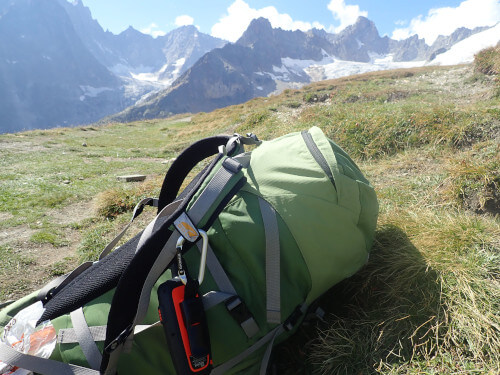

Knowing what to pack for a hut to hut tour in the Alps can be a big challenge, especially if you have never been on one before. It’s important to ensure you have a light pack so that it doesn’t become too much of a burden, while on the other side it is critical have all the items you need to ensure safety and a tolerable comfort while on the trail.
Beginner hut to hut hikers have two things working against them: their backpacks are almost always heavier than those more experienced than them and their muscles aren’t as developed for hiking so the trail is going to be more strenuous for them.
EVERY GRAM REALLY DOES COUNT. If you already started doing some research, you probably already came across this before. It’s true. Not only does each individual gram add up, but each individual gram also needs to be lifted by your leg muscles with every single uphill step you take along the way. This adds up exponentially on your tour. Take this seriously.
Here we share not only our packing list with you, but also some additional thoughts about decisions to make along the way.
The Backpack


Your backpack is a critical piece of gear and is not something you want to skimp on. I recommend a pack size between 24 liters and 30 liters. If you need a pack that is larger than 30 liters for an in-season hut hiking tour, then you are bringing too much stuff. Packs come with a lot of fancy features these days, but at a minimum, you need a pack with a good hip belt and a sternum strap. I also like to have pockets on the hip belt and accessibility to my water reservoir from outside the pack. Keep in mind that the more features your pack has, and the more structure and padding it has, the heavier it will be.
Your backpack is not something that should blindly purchase online, even if you base that purchase on reviews or on a friend’s advice. The way a pack fits you is critical. My recommendation is to go to your local gear store and try on the packs that they have. Make sure you load them with some weight. Once you find a brand that fits you, then you can take a look at all the packs they offer and decide which features you like the best. And bonus points, if you support your local gear store and buy the pack from them.
Clothing
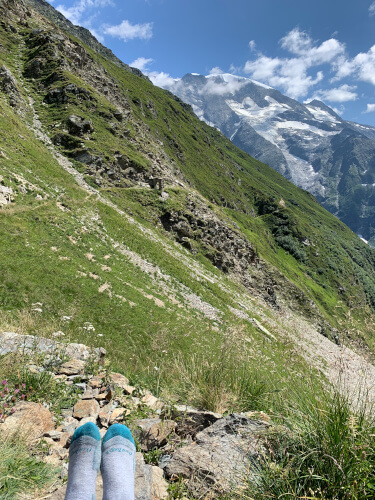

Most first-time hikers pack way too much clothing. Experienced hikers cut out weight by washing as they go. And while it’s polite for anybody staying in a hut to keep body odor somewhat under control, it’s certainly not necessary to have detergent-fresh clothes each day.
When it comes to clothes for a hut hiking tour in the Alps, it is really important to avoid cotton. Cotton holds moisture and dries slowly. In the unlikely event that you injure yourself or get lost and do not make it to the hut in the evening, cotton can turn an uncomfortable night in a dangerous one by holding moisture and lowering your body temperature. You want clothing that will dry quickly. It is; however, great to have a comfy a cotton t-shirt to wear around the hut in the evening.
We have our standard clothing list, but we always check the weather forecast shortly before we head out and make adjustments:
- Socks (2 to 3 pair)
- Underwear (2 to 3 pair)
- Shorts (1 pair)
- Long pants (1 pair)
- Baselayer bottoms (1 pair)
- 2-shirts for hiking
- 1-comfortable shirt for sleeping and wearing in the hut
- Long-sleeved shirt
- Rain jacket
- Rain pants
- Warm jacket for the evenings, such as a down or fleece jacket
- Warm hat
- Warm gloves
- Optional: Buff, or other tubular bandana, is one of our favorite trail essentials
If the weather forecast looks very sunny and warm with very little rain, I might substitute a second pair of shorts for the long pants and may remove the rain pants as well.
Toiletries
I consider toiletries to be the number one category where people overpack. The truth is, that while you may have a specific skin care routine you follow at home, it’s also probably something you can survive without for the 10 days or so you are on the trail. And who needs to put face moisturizer on when they have to put on sunscreen everyday anyway? Over the years, I have cut the toiletries in my backpack down significantly. I have fairly long hair and no longer even carry a brush. Of course, each individual person may have specific items they need, such as medication or cleaning solution for contacts.
- Deodorant
- Toothbrush
- Toothpaste
- Soap (multi-purpose to be used as shampoo, body wash, hand wash and for washing clothes)
- Tissues (I use these for my nose and also for toilet paper while on the trail – please carry out all toilet paper in a ziplock bag and dispose of it appropriately in town)
Hut Essentials
There are certain items that are critical to bring to the huts. We recommend that you pack every single one of these.
- Sleeping bag liner – REQUIRED! (a full sleeping bag is required during the COVID-19 pandemic)
- Cash in the right currency – REQUIRED! (euros in France and Italy, Swiss Francs in Switzerland)
- Small, packable hand towel
- Soap or hand sanitizer – REQUIRED
- Ear plugs
- Slippers or sandals to wear around the hut
- Identification
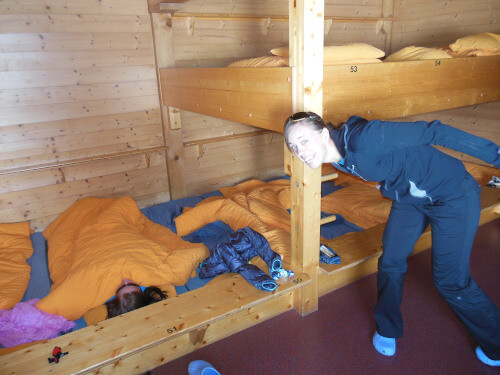

A sleeping bag liner is required by the huts for hygiene reasons. The huts generally provide mattresses, pillow and blankets, but they don’t have the capacity to wash them between each use. For this reason, it is very important that you have a sleeping bag liner, also called a hut sleeping bag, so you don’t end up sleeping in their dirty bedding and making it even dirtier. Even better than a sleeping bag liner is a Travel Sheet. A travel sheet has a rectangular pocket at the top that the pillow slips perfectly into. In most years, we discourage full sleeping bags, because the huts tend to get extremely warm in the shared rooms at night.
NOTE: During the COVID-19 pandemic, the huts may not provide blankets and pillows, and you may need to carry a full sleeping bag with you.
Food
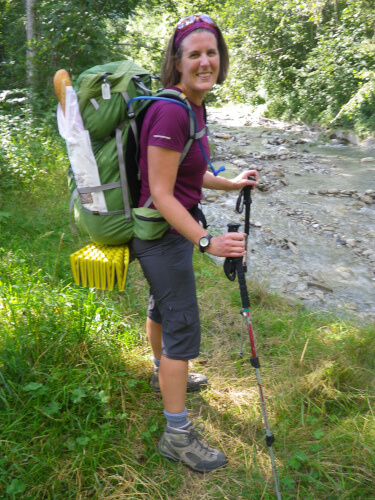

Most people who do the Tour du Mont Blanc will eat dinner and breakfast at their accommodation, and some may even get a picnic lunch to bring with them during the day. There are several towns along the way that have grocery stores, so you never really have to carry too much food with you.
It is possible to shop in Chamonix, Les Houches, Les Contamines-Montjoie, Courmayeur, La Fouly, and Champex. Les Chapieux has a great cheese shop.
- Snacks (we recommend bread from the bakery, cheese and sausage)
- Small garbage bag (please do not leave your trash at the huts)
If you are planning to stay at the huts, but are not planning on eating there, you need to bring supplies so you can be self-sufficient. The huts usually will not provide any resources for cooking. It is also necessary to cook away from the hut property.
Water
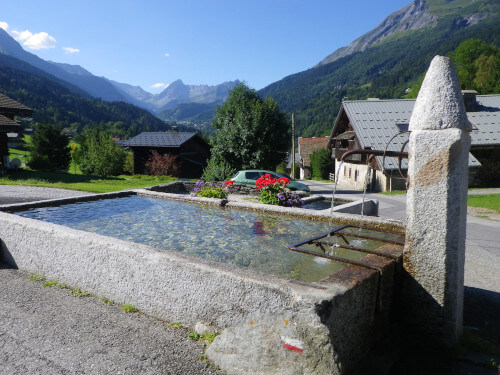

There are regular opportunities to fill up with water along the way, in particular at the huts. Many of the villages have fountains with drinking water available. Although it should not be necessary, if you do need to collect water from streams, please treat it as there is evidence of livestock and wild animals throughout the Alps. If you are concerned about water, I recommend carrying emergency water treatment tablets instead of a filter, as the probability of using it is so small, it’s certainly not worth the weight.
- Adequate water supply and carrying capacity for your hydration needs (2+ liters per day)
- Optional: ½-liter Nalgene bottle or small water bottle to assist with refilling water from hut sinks
- Optional: Emergency water treatment tablets
Navigation and Safety (10 Essentials)
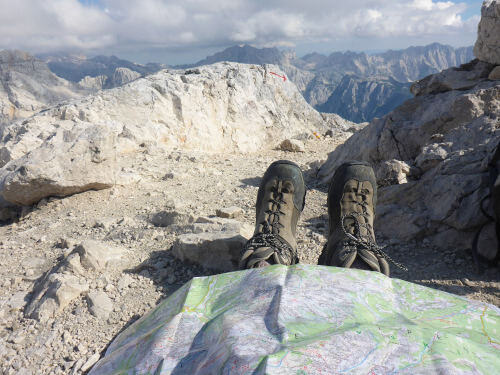

The Ten Essentials is a list out of North America of the items everybody should have in their backpack in order to be able to survive a night out in an emergency. While the Alps lack a “backcountry” feel and the nearest hut or village is never very far away, this list remains a great guide for the necessities, as well as for items that you never really want to use but should always have with you.
- Paper Map
- Optional: Tour du Mont Blanc Guidebook from Knife Edge Outdoor
- Compass
- Optional: GPS or navigation app for your smart phone
- Rain cover for your backpack
- Sun protection (sunblock, sunglasses, and a hat)
- First aid kit (include tweezers, as ticks are common in the Alps)
- Knife and repair kit
- Headlamp with extra batteries
- Fire starter
- Emergency shelter (emergency blanket)
While there are a lot of great electronic navigation options available today, it is still critically important to carry a paper map. The trail is well signed out, but one of the most valuable skills for safety is to be able to navigate to your hut. Anything electronic has a high potential for failure, so always carry a paper map.
Electronics
Everybody has their own selection of electronics that they want to bring along. Remember though that these usually add a great deal of weight and probably require charging in the evening. Charging may not be available every day, as many of the huts have limited power outlets available. For this reason, we recommend bringing a power bank along.
- Cell phone
- Power bank
- Optional: digital camera
- Optional: GoPro
- Optional: GPS device
- Necessary charging cables and European plug adapter
A note about drones: drones can be extremely disruptive to those enjoying the trail. If it is absolutely necessary for you to bring a drone, please limit its use to times when there are not other hikers around to disrupt.
Other Items
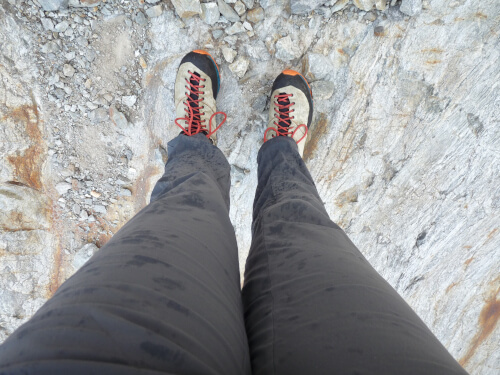

- Sturdy hiking shoes
- Hiking poles
- Optional: micro-traction for any ice that may be present on the trail (recommended for early-season tours)
There is an ongoing debate about whether it is best to wear classic, ultra-supportive and heavy hiking boots, or if it is best to wear lighter, trail running shoes. As long as you are not too early in the season when there is still snow around, either option should work just fine. There is not any terrain where trail running shoes would be inappropriate. If you do opt for trail running shoes; however, it is important that you are able to build up the strength in your ankles for such a long tour before starting the tour. Also, it may help to know that the number one cause for search and rescue operations in the Alps are ankle injuries.
The terrain in the Alps is steep and hiking poles are very strongly recommended for the tour, especially for the downhill terrain.
Putting it all Together
The best way to manage your pack weight is to keep track of EVERYTHING you are packing. I like to list each item in an excel spreadsheet and weigh it individually on the kitchen scale, including my backpack. This allows me to really study it, send it to more experienced friends for their input, and to make objective decisions about what items I can remove or reduce in order to make my pack lighter. A pack weight of 10 kilograms, or 22 pounds, is more than enough. I usually get my pack down around 6 kilograms with water, but without food.
Packing your backpack is an art form. Technically speaking, your heaviest items should be closest to your back in the lower two-thirds of your backpack, but not hanging below the hip belt. Your heaviest items are usually your water, food and electronics. You should avoid items hanging off your pack as much as possible. Every time something on your pack swings, it adds additional resistance which your body will experience as added weight. This can add up exponentially as you move your way along the trail. With that said, there’s also a practical strategy to packing, so that the items you need while on the trail are readily accessible without unpacking everything.
Here are a few tips:
- I keep just a few snacks easy to access, either in the side pockets or the lid pocket of my pack
- All other snacks and lunch food are stashed away inside the pack, in the lower two-thirds close to my back
- I carry my water in a Platypus reservoir and buy packs with a pocket for it directly next to my back (almost all packs have this feature today). This keeps the heavy water close to my back
- Depending on the weather forecast and anticipated trail conditions, I’ll often strategically keep items that I may need at the top. This includes raingear, microspikes for my feet if I expect snow or ice, and any additional layers I may want to pull out quickly
Conclusion
Packing all the right items, and none of the wrong items, for your tour can make a huge difference. You’ll have more fun on the trail if your pack is light, but it is important not to lose sight of safety and some level of comfort while on tour.
If you want to dive into this topic more, check out our FREE Webcast on Packing for the Tour du Mont Blanc. You can catch a live version if we have one in the schedule, or you can always check out our recorded version, using a FREE member page login that takes only seconds to set up.
